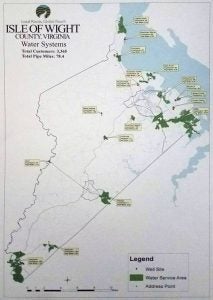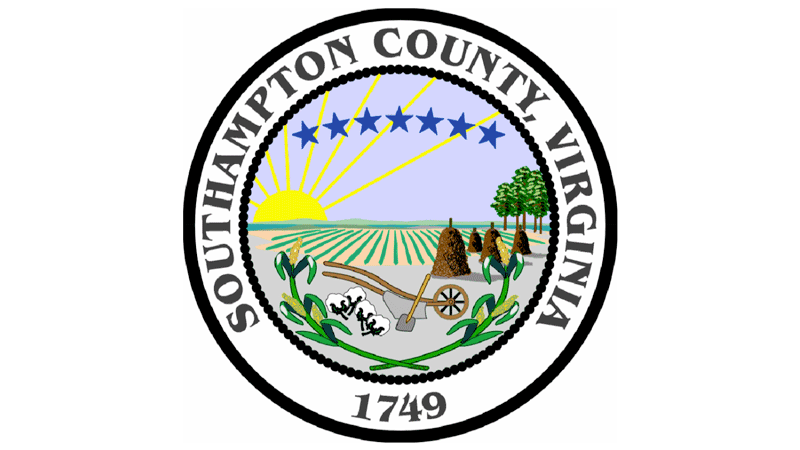Water-sewer task force discusses assets, DEQ regs
Published 10:32 am Friday, January 20, 2017
SMITHFIELD
According to data compiled by Isle of Wight’s intergovernmental water-sewer task force, residents and businesses located within the county who receive their water via a town or county source collectively consume approximately 2 million gallons of water per day.

This map of Isle of Wight County, presented during the water-sewer task force meeting, shows the location of county-owned wells and water service areas throughout the county. — Submitted
Assuming the county’s population grows at a rate of approximately 2 percent per year, which is in keeping with the county’s historical average growth, by the year 2038 Isle of Wight would likely be consuming approximately 5 million gallons per day, which is the maximum the Virginia Department of Environmental Quality will permit the county to withdraw from a combination of surface and well water sources.
This was the conclusion the task force reached following their efforts to identify all of the county’s water and sewer assets and current usage data, which was presented at the task force’s January meeting, held on Wednesday at 3 p.m. in a conference room at the Isle of Wight Volunteer Rescue Squad building in Smithfield.
According to task force chairman Dick Grice, the DEQ is particularly interested in reducing municipalities’ reliance on aquifer (well) water, which they consider to be a state natural resource.
“Windsor is in negotiation with them and the Western Tidewater Water Authority right now,” Grice said. “It’s not just here; it’s throughout the entire state [that they are trying to reduce aquifer dependence.]”
Grice added that Windsor has a DEQ permit to pump approximately half a million gallons of water out of the ground per day, and the town of Smithfield has a slightly higher allocation. The WTWA, which supplies water to Isle of Wight County and Suffolk, has a permit to pump 8.3 million gallons currently, but that figure is in the process of being reduced by nearly 50 percent.
“If you cut somebody’s water off, you’re going to have to replace it with something, and we’re going to have to use surface water,” Grice said. “That’s what the Norfolk water deal is about — surface water.”
Now that the Norfolk water deal is in effect, the WTWA currently has approximately 4 million gallons per day available with the City of Norfolk, with that amount increasing to 15 million gallons per day available beginning in 2037.
The amount of water available to WTWA is expected to increase by 1 million gallons per day every two years until reaching a constant 15 million gallons per day beginning in 2037 and continuing through 2048.
As an additional measure to address this issue, the task force is looking into the possibility of interconnecting the various county-owned and town-owned water systems located throughout the county.
According to data presented by Don Jennings, the county’s director of utility services, the county currently has approximately 3,300 water customers on county lines, including wells, and a total of 23 water systems under county control. The county’s 185 water customers in the Camptown area at the county’s southern tip, are supplied with water purchased by the county from the City of Franklin.
The town of Smithfield has its own groundwater withdrawal permit through summer 2023, two groundwater wells, three elevated storage tanks with a capacity of 1,050,000 gallons, approximately 335,500 linear feet (63.5 miles) of waterline ranging from one inch to 16 inches in diameter, and one 1.5 million gallon-per-day reverse osmosis water treatment plant. Total water assets for the town are valued at $7,684,289.
Smithfield’s sewer assets include 27 sewage pump stations and gravity sewer basins, seven of which are considered terminal stations, and 2,818 sewer customers. The town’s sewer assets are valued at $4,037,892.
The town of Windsor’s water assets include one well located on East Griffin Street with a storage tank capacity of 150,000 gallons, and another well located on U.S. Route 258 with a storage tank capacity of 300,000 gallons.
Windsor is already permitted by the DEQ to withdraw 597,000 gallons per day, and the demand for water in town is approximately 220,000 gallons per day. Windsor has approximately 850 municipal water customers.
Jennings added that connecting the two town’s systems with each other and with county lines might be difficult.
“The town uses chlorine to disinfect their water; WTWA uses chloramine,” Jennings said. “When they are mixed together, they produce a very foul odor.”
Another issue that may arise in the near future is fluoride levels. Currently, the DEQ allows water systems to have between 2 and 4 percent fluoride levels, but may decide to lower that amount to under 2 percent. If that change becomes official, some systems within the county would need upgrades to further treat the water in order to remain compliant with state laws.
Windsor Town Manager Michael Stallings added that he believed it would be a hard sell to residents of Isle of Wight County and Windsor who are on private wells to go on a municipal system and pay monthly fees when they could simply buy a reverse osmosis filter from Lowe’s for their home for around $200.
The task force also has added two new members: Daryl Butler, a resident of the Carrsville area, who was recommended by Isle of Wight Board of Supervisors Chairman Rex Alphin to represent the Carrsville District, and Amy Ring, the county’s new planning and zoning director.
The task force’s next meeting will be on Wednesday, Feb. 8 at 3 p.m., again at the Isle of Wight Volunteer Rescue Squad building, and may include representatives from the Hampton Roads Sanitation District. For their March meeting, the task force plans to invite representatives of Southampton and Surry counties.





